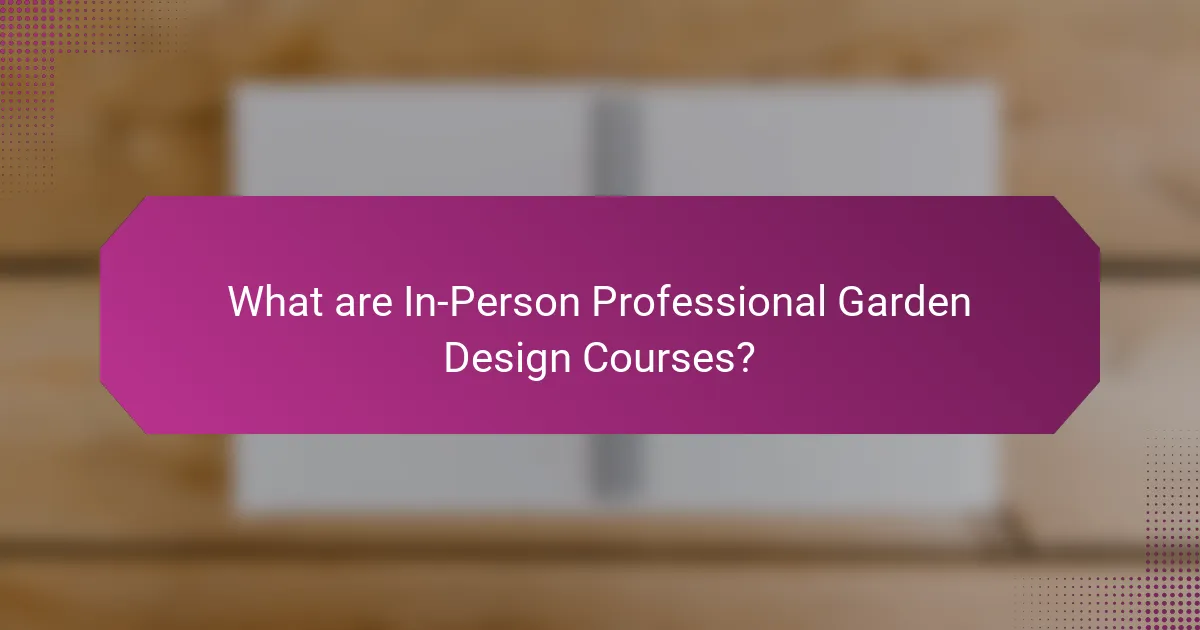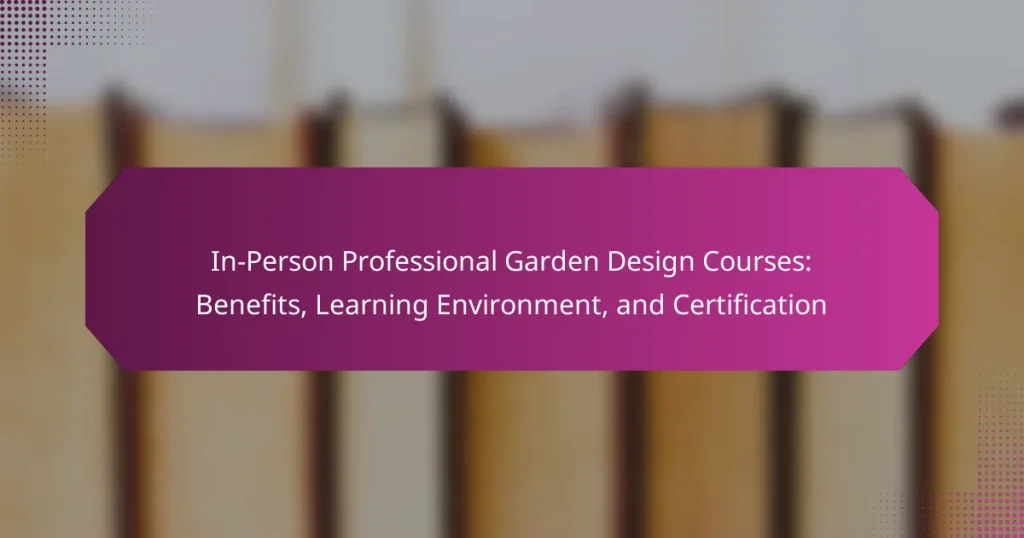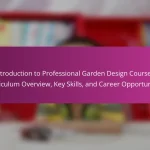
What are In-Person Professional Garden Design Courses?
In-person professional garden design courses are educational programs that teach individuals the principles and practices of garden design. These courses typically involve hands-on learning experiences in a physical classroom or outdoor setting. Participants engage with instructors and peers, allowing for immediate feedback and collaboration. The curriculum often covers topics such as plant selection, landscape design, and ecological considerations. Students may also learn about design software and tools used in the industry. Many courses offer opportunities for practical application through projects and field trips. Upon completion, participants may receive certification, enhancing their qualifications in the field.
How do In-Person Professional Garden Design Courses differ from online courses?
In-person professional garden design courses offer hands-on experience and direct interaction with instructors. This allows for immediate feedback and personalized guidance. Students can engage in practical activities, such as planting and design work, in real-time. Online courses, conversely, provide flexibility and accessibility but lack physical interaction. They often rely on video lectures and digital assignments. In-person courses foster networking opportunities with peers and industry professionals. Research shows that experiential learning enhances retention of skills and knowledge. Therefore, in-person courses may lead to deeper understanding and application of garden design principles compared to online formats.
What are the advantages of in-person learning for garden design?
In-person learning for garden design offers several advantages. It provides hands-on experience, allowing students to engage directly with plants and materials. This tactile interaction enhances understanding of plant care and landscape planning. Additionally, in-person classes foster immediate feedback from instructors. Students can ask questions and receive guidance in real time. Networking opportunities are also significant; learners connect with peers and industry professionals. This collaboration can lead to future partnerships or job opportunities. Furthermore, in-person settings often include field trips to gardens and landscapes. These excursions provide practical insights that online courses cannot replicate. Overall, in-person learning enriches the educational experience in garden design.
What are the limitations of online courses in garden design?
Online courses in garden design have several limitations. They often lack hands-on experience, which is crucial for practical skills. Students miss out on real-time feedback from instructors. Networking opportunities with peers and professionals are limited in an online setting. Access to physical materials and tools for design practice is restricted. Online courses may not provide the same level of engagement as in-person classes. Additionally, some online programs lack accreditation, affecting their credibility. Lastly, the variability in internet access can hinder learning for some students.
What key topics are covered in these courses?
Key topics covered in In-Person Professional Garden Design Courses include landscape design principles, plant selection, and garden planning. Students learn about design aesthetics and functionality in outdoor spaces. Courses also cover soil management and sustainable gardening practices. Additionally, students explore hardscaping and water features. The curriculum often includes hands-on projects and site analysis techniques. Certification requirements may also be discussed, emphasizing professional standards in garden design. These topics ensure a comprehensive understanding of garden design.
What foundational principles of garden design are taught?
Foundational principles of garden design include balance, unity, proportion, and rhythm. Balance ensures visual stability in a garden’s layout. Unity creates a cohesive look, tying different elements together. Proportion relates to the size of plants and structures in relation to each other. Rhythm involves the repetition of elements to guide the viewer’s eye. These principles are fundamental in creating aesthetically pleasing and functional garden spaces. Understanding these principles enhances the design process and leads to successful garden outcomes.
How do courses address plant selection and maintenance?
Courses address plant selection and maintenance by providing structured curricula focused on horticultural principles. They cover the identification of plant species suitable for specific climates and soil types. Instruction includes understanding plant growth requirements, such as light, water, and nutrients. Maintenance techniques taught include pruning, pest management, and fertilization strategies. Hands-on activities often reinforce theoretical knowledge through practical application. Many courses also emphasize sustainable practices in plant care. This approach helps students develop skills for long-term garden health and aesthetics.
What are the benefits of enrolling in In-Person Professional Garden Design Courses?
Enrolling in In-Person Professional Garden Design Courses offers numerous benefits. Participants gain hands-on experience with expert instructors. This direct interaction fosters immediate feedback and personalized guidance. Courses often include practical projects that enhance design skills. Networking opportunities arise from collaborating with peers in the field. In-person settings encourage a focused learning environment without distractions. Students also receive access to industry resources and materials. Many courses lead to recognized certifications, boosting career prospects.
How do these courses enhance practical skills?
In-person professional garden design courses enhance practical skills by providing hands-on experience in real-world settings. Students engage in live projects, allowing them to apply theoretical knowledge directly. These courses often include workshops that focus on specific techniques, such as plant selection and landscape layout. Participants receive immediate feedback from instructors, which helps refine their skills. Additionally, collaborative projects foster teamwork and communication abilities. Access to professional tools and materials during training enhances technical proficiency. According to a study by the American Society of Landscape Architects, practical training significantly boosts confidence and competence in design implementation.
What networking opportunities do participants gain?
Participants gain valuable networking opportunities through in-person professional garden design courses. These courses facilitate connections with industry professionals, such as experienced designers and horticulturists. Participants can engage in discussions, share ideas, and collaborate on projects. Additionally, networking with peers can lead to future partnerships or job opportunities. Many courses also include guest speakers from the industry, enhancing exposure to various perspectives. This interaction fosters a sense of community among participants, encouraging ongoing relationships beyond the course. Ultimately, these networking opportunities can significantly enhance participants’ careers in garden design.

What is the learning environment like in these courses?
The learning environment in in-person professional garden design courses is interactive and hands-on. Students engage directly with instructors and peers in a collaborative setting. Classrooms often include practical workshops and outdoor sessions for real-world application. This approach enhances understanding of design principles and plant care. Facilities typically feature gardens, design studios, and access to various gardening tools. The environment fosters creativity and encourages experimentation with different design styles. Additionally, instructors provide personalized feedback to support individual learning. This structure promotes a comprehensive understanding of garden design concepts and techniques.
How is the classroom experience structured?
The classroom experience in in-person professional garden design courses is structured around interactive learning. Students engage in hands-on activities, such as plant identification and garden layout design. The curriculum typically includes lectures, discussions, and practical workshops. Instructors provide real-time feedback during exercises. Group projects foster collaboration among students. Assessments may include presentations and design portfolios. This structure enhances both theoretical knowledge and practical skills. Research shows that interactive learning improves retention and application of knowledge.
What types of hands-on activities are included?
Hands-on activities included in in-person professional garden design courses typically encompass plant identification, soil analysis, and landscape sketching. Students engage in practical exercises that enhance their understanding of horticultural principles. Activities may also involve creating garden layouts and implementing design concepts in real-world settings. Workshops often facilitate the use of tools and techniques relevant to garden design. These experiences provide learners with applicable skills for future projects. Each activity reinforces theoretical knowledge through practical application.
How do instructors facilitate learning in a physical setting?
Instructors facilitate learning in a physical setting by creating an interactive and engaging environment. They utilize hands-on activities to enhance practical skills. Instructors also encourage group discussions to promote collaboration. They provide immediate feedback to reinforce understanding. Visual aids and demonstrations help clarify complex concepts. Structured lesson plans guide the learning process effectively. By fostering a supportive atmosphere, instructors motivate students to participate actively. This approach leads to improved retention and application of knowledge in garden design.
What resources are available to students during the course?
Students in in-person professional garden design courses have access to various resources. These resources include experienced instructors who provide hands-on training. Students can also utilize design software for creating garden layouts. Access to plant specimens and materials for practical work is often provided. Libraries or online databases may offer reference materials for research. Networking opportunities with industry professionals are available during the course. Workshops and seminars may enhance learning through specialized topics. Additionally, students often receive course materials such as textbooks or guides. These resources collectively support students in gaining practical skills and knowledge in garden design.
What types of materials and tools do students use?
Students use a variety of materials and tools in garden design courses. Common materials include soil, plants, and seeds. Tools often consist of shovels, trowels, and pruners. Additionally, students may use design software for planning layouts. Measuring tools like rulers and tape measures are essential for accurate designs. Students also utilize gloves and safety gear for protection. Each tool and material supports hands-on learning and practical application. These resources enhance students’ understanding of garden design principles.
How does access to gardens or landscapes enhance learning?
Access to gardens or landscapes enhances learning by providing a hands-on, immersive educational experience. Engaging with nature stimulates curiosity and fosters observational skills. Students can apply theoretical concepts in real-world settings. This practical application reinforces knowledge retention. Studies show that outdoor learning environments improve focus and reduce stress. Research indicates that students in garden settings perform better academically. Interaction with plants and landscapes promotes critical thinking and creativity. Overall, gardens serve as dynamic classrooms that enrich the learning process.

What certification options are available for graduates?
Graduates of in-person professional garden design courses have several certification options available. These certifications may include the Certified Landscape Designer (CLD) credential. Another option is the Landscape Industry Certified Technician (LICT) certification. Graduates can also pursue the Master Gardener certification offered by various agricultural extensions. Additionally, some institutions provide their own certifications specific to garden design. These certifications validate skills and knowledge in the field. They enhance employability and credibility in the industry. Certification requirements vary by program and location.
How does certification impact career opportunities in garden design?
Certification enhances career opportunities in garden design by validating expertise and skills. It signals professionalism to potential employers and clients. Certified garden designers often have access to a broader network of industry contacts. This can lead to job placements and collaboration opportunities. Statistics show that certified professionals tend to earn higher salaries compared to non-certified peers. According to a survey by the American Society of Landscape Architects, 70% of firms prefer hiring certified candidates. Certification also provides credibility, making it easier to attract clients. Overall, certification significantly improves job prospects and professional growth in garden design.
What are the requirements for obtaining certification?
To obtain certification in professional garden design, candidates typically need to complete a recognized course. This course should cover essential topics in garden design principles, plant selection, and landscape planning. Additionally, candidates may need to submit a portfolio showcasing their design projects. Some programs also require passing a final exam to demonstrate knowledge and skills. Experience in the field, such as internships or practical work, can be beneficial. These requirements ensure that certified individuals possess the necessary expertise in garden design.
How do different certifications vary in recognition and value?
Different certifications vary in recognition and value based on industry standards and institutional reputation. Certifications from well-known organizations often carry more weight in hiring decisions. For example, certifications from accredited institutions like the American Society of Landscape Architects are highly regarded. Conversely, lesser-known certifications may not be recognized as widely. The value of a certification can also depend on regional demand for specific skills. In the garden design field, recognized certifications can enhance job prospects and potential salaries. Research indicates that professionals with respected certifications earn higher wages than those without.
What are the next steps after completing a course?
After completing a course, the next steps include applying learned skills in practical projects. This can involve designing gardens or collaborating with professionals in the field. Networking with peers and instructors is crucial for future opportunities. Updating your resume to reflect new qualifications enhances job prospects. Seeking internships or volunteer positions can provide hands-on experience. Additionally, pursuing certification may validate your skills further. Engaging in continuous learning keeps you updated with industry trends. Finally, sharing your work on platforms like social media can showcase your expertise.
How can graduates apply their skills in the job market?
Graduates can apply their skills in the job market by leveraging their specialized knowledge in garden design. They can pursue careers as landscape designers, horticulturists, or garden consultants. Many employers seek candidates with hands-on experience and creative problem-solving abilities in outdoor spaces. Graduates can showcase their portfolios to demonstrate their design capabilities. Networking with industry professionals can also provide job opportunities. Additionally, obtaining certifications can enhance their credibility and marketability. According to the U.S. Bureau of Labor Statistics, employment for landscape architects is projected to grow by 4% from 2019 to 2029, indicating a steady demand in the field.
What additional training or education might be beneficial?
Additional training or education that might be beneficial includes landscape architecture courses. These courses provide advanced design principles and technical skills. Horticulture classes enhance knowledge of plant species and care. Business management training can help with client relations and project management. Workshops on sustainable practices are increasingly relevant in garden design. Online courses on software like AutoCAD or SketchUp can improve design presentation skills. Certifications in permaculture design can also add value to a garden designer’s credentials. Each of these educational opportunities complements the foundational skills gained in professional garden design courses.
What tips can help maximize the experience in In-Person Professional Garden Design Courses?
Engaging actively in class discussions maximizes the experience in in-person professional garden design courses. Participation enhances understanding and retention of concepts. Networking with instructors and peers fosters collaboration and support. Bringing a notebook for sketches and notes aids in capturing key insights. Visiting local gardens for inspiration complements classroom learning. Practicing design techniques outside of class solidifies skills. Seeking feedback on projects encourages growth and improvement. Finally, staying organized with deadlines and assignments ensures a smooth learning experience.
In-Person Professional Garden Design Courses are educational programs that provide hands-on training in garden design principles and practices. The article explores the advantages of in-person learning, including immediate feedback, networking opportunities, and practical application through projects. Key topics covered in these courses include plant selection, landscape design, and sustainable gardening practices, along with foundational principles such as balance and unity. Additionally, the article discusses certification options available for graduates and the impact of certification on career opportunities in the field. Overall, the content emphasizes the importance of interactive learning environments in enhancing skills and knowledge in garden design.


